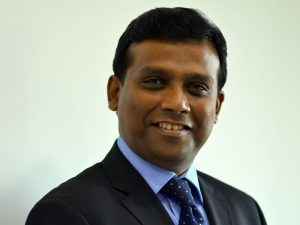 INFRA
INFRA
 INFRA
INFRA
 INFRA
INFRA
To veteran tech watchers, the name Infosys Ltd. recalls the offshore outsourcing boom of the late 1990s, when the company and others such as Tata Consultancy Service Ltd. and Wipro Ltd. burst on the scene to offer low-cost coding services by skilled Indian programmers at a small fraction of the cost of domestic labor.
Times have changed — and so have the business models of those so-called offshoring firms. Although Infosys still employs 89 percent of its workforce in India, nearly-two thirds of its business is stateside. It’s on a campaign to look more American as its business evolves into areas such as digital transformation consulting, analytics, financial services, cloud management and machine learning.
The company is in the middle of a two-year campaign to bulk up its U.S. workforce amid one of the toughest hiring environments in memory. Its secret weapon is training. If you can’t hire the best people, Infosys executives believe, you should make them instead.
“We have no chance of hiring at the scale we need,” Ravi Kumar, president and deputy chief operating officer of Infosys, said in an interview with SiliconANGLE. “We are creating skills that don’t exist in the market today.”

Infosys President Ravi Kumar (Source: Infosys)
The shift is partly in response to changing customer attitudes. The offshoring craze of two decades ago came at a time when information technology was widely seen as being on its way to low-cost utility status.
Now, the recent rise of web-scale giants, along with corporate America’s current fascination with digital transformation, has turned that attitude on its head. IT now is the business. That’s moving the onetime low-cost providers up the value scale.
“Clients are saying their work is more strategic, so they want it in-sourced,” Kumar said. “Large corporations are asking us to be in their proximity.”
So Infosys is becoming more American. Last spring, it announced plans to hire 10,000 people in the U. S. over the next two years, and it’s already 40 percent of the way toward that goal.
The company also plans to create four technology innovation hubs – codevelopment centers organized around hot technologies such as artificial intelligence and big data — in Indianapolis, Raleigh, Providence and Hartford. The $245 million Indianapolis facility will transform a 70-acre former airport terminal into the company’s U.S. training center and employ 3,000 people by 2023.
The expansion comes amid an epic shortage of skilled IT professionals created by the combination of growing corporate investments in digital initiatives and the inability of educational institutions to keep up with demand. In a survey of 4,000 chief information officers by Harvey Nash Group PLC and KPMG LLC, nearly two-thirds said a lack of talent is holding back their organizations. The government estimates that there will be an average of 366,000 new openings for IT professionals annually between now and by 2026, with colleges producing only 60,000 computer science graduates each year.
Infosys confronts the same hiring problems as everyone else, so it’s focusing on growing skills internally. Through its Infosys Foundation philanthropic arm, the company has funded computer science training for more than 134,000 in 2,500 schools across the U.S. over the past three years.
In June, it partnered with the Rhode Island School of Design to train more than 1,000 employees in human- and design-centric technology skills. “We’re taking liberal arts talent and putting them through an eight- to 12-week program that will make them digital designers of the future,” Kumar said.
Another partnership with Udacity Inc. will immerse 500 engineers in a 20-week crash course in autonomous vehicle technology. And it’s launching an immersive training program to turn people with backgrounds in threat hunting and identity management into well-rounded cybersecurity professionals amid predictions that the skills gap there could total 3.5 million jobs by 2021.
Infosys declined to say how much all of this is costing, choosing instead to stress that training is integral to the culture of the 37-year-old company. Launched by seven engineers with just $250 in initial investment in 1981, Infosys today operates the world’s largest corporate university, on a 337-acre campus in Mysuru, India (pictured). It provided more than 2 million days of training for its 200,000 employees in 2017, according to its most recent annual report. “We have been built with lifelong learning as a philosophy,” Kumar said.
Rather than relying upon academic institutions to produce fully skilled technology professionals, the company recruits from a variety of backgrounds, including liberal and fine arts students, and trains them on the job. It has hired 1,400 people from U. S. schools over the past year, putting many through what Kumar called a “finishing school to create new talent.”
The company reasons that its emphasis on continual skills development will set it apart from tech competitors dangling stock options and signing bonuses. When research sites for its innovation hubs, it steered clear of Silicon Valley in favor of locations close to both customers and educational institutions in business-friendly states. And it publicly set hiring goals in each location.
Building skills internally isn’t cheap, but Kumar reasons that the payoff is in motivated employees who stay longer. “If I can make a campus hire productive, it gives me lower cost, scale and new-age talent who’s hungry to do more than we ask them to do,” he said.
In India, at least, this strategy appears to be working. Infosys’ attrition rate of 15 percent in 2017 was well below the 20 percent average for the Indian IT consultancy industry. And it appears to have the pick of the litter in its home territory. The company said it received nearly 1.3 million applications for employment last year and extended just 51,000 offers, a hiring rate of less that 4 percent. By contrast, Harvard University accepts about 6 percent of freshmen applicants.
THANK YOU